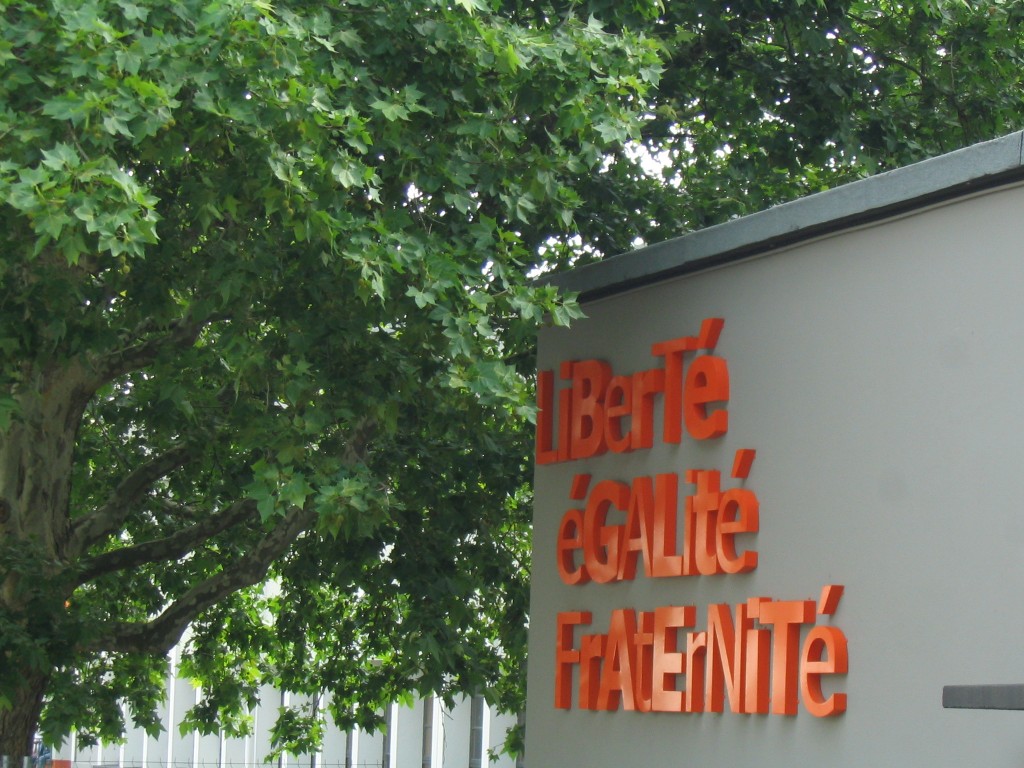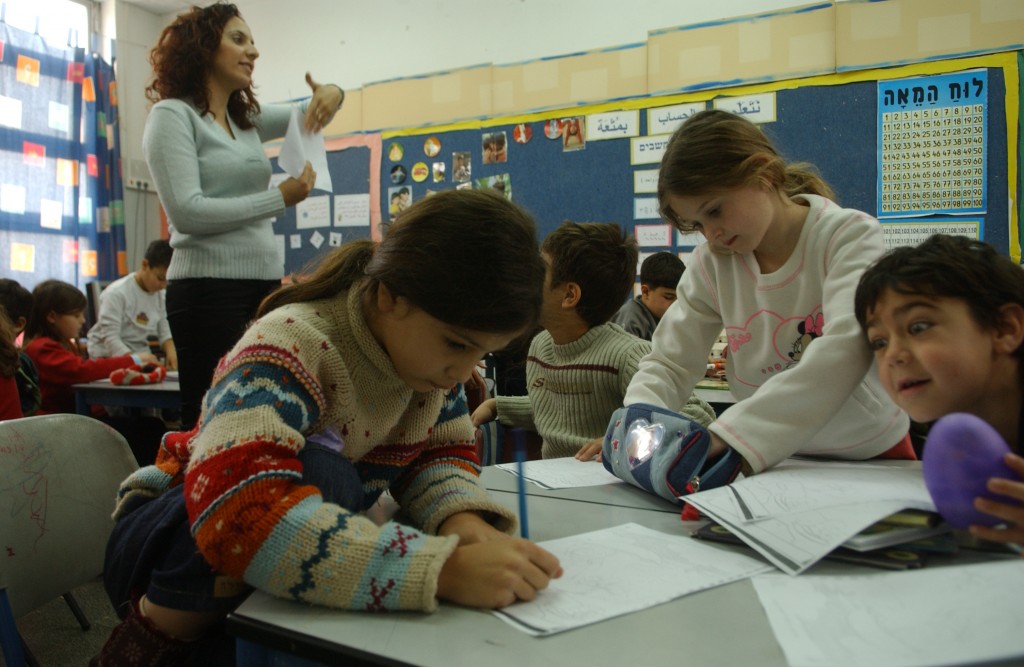By every conceivable standard of liberalism, Israel comes out surprisingly ahead. A definitive look at the numbers.
In a 2011 blog post titled “A Few Notes on WHAT IS LEFT (or Toward a Manifesto for Revolutionary Emancipation),” the prominent radical intellectual Richard Falk endeavored to distill “what remains of the historic left” into a program of contemporary relevance. The starting point he proposed? “Support for the Palestinian Solidarity Movement.”
This is not surprising, as Falk is the UN’s Special Rapporteur on Palestine and a ferocious supporter of the Palestinian cause. But his views are not unusual. Falk was simply expressing what has been implicit among progressive academic associations, unions, churches, and human rights groups that single out Israel for censure or punishment. Championing the Palestinians and opposing Israel has become a touchstone, perhaps the touchstone, of the contemporary Left.
This reflects a larger transformation of Leftist concepts from that of the working class versus the bourgeoisie to that of the Third World versus the First World, or “the rest against the West,” an idea that grew out of the struggle against Western colonialism. It places Israeli irredeemably in the wrong and bathes the Palestinian cause in nobility.
But the Israeli hold on the West Bank and those that live there, oppressive as it can be, ill fits the mold of colonialism. It is an occupation that did not emerge out of greed or the desire for political power, but out of a defensive war, and most Israelis would relinquish it if the Palestinians would make it safe to do so.
Moreover, when viewed in the light of the core values of the Left—and, indeed, much of the contemporary Right—Israel actually comes off remarkably well; often much better than its most violent critics. These values are summed up by the great slogan of the French Revolution: “liberté, egalité, fraternité,” “liberty, equality, fraternity.” Israel’s record with respect to these core values ranks among the best in the world, while that of its principal enemies, the Arab nations, is dismal. Indeed, Israel’s record is in some cases better even than its European and other Western critics. Because this record is often obscured in the angry polemics against Israeli policies toward the Palestinians, it is worth examining it in depth.
“Liberty” is usually understood as meaning freedom and democracy, which remain the most basic measures of a nation’s respect for human dignity. We can compare different countries’ records on this issue through the findings of the NGO Freedom House, which each year issues a list of “electoral democracies” and scores all countries numerically, with 1 being the best possible score and 7 the worst. Countries that score from 1 to 2.5 are “free,” those from 3 to 5 are “partly free,” and those from 5.5 to 7 are considered “not free.”

Photo: Cédric Lafonte / Wikimedia
Freedom House considers Israel an “electoral democracy.” Its freedom rating is 1.5. This qualifies as “free,” but is a notch less perfect than most Western countries. However, it is worth considering the context. Even liberal democracies tend to become less free when their safety or survival is threatened. American civil liberties suffered because of the War on Terror, not to mention earlier, more fraught moments in American history; the right of habeas corpus was suspended during the Civil War, and anti-war dissenters were imprisoned during World War I. During World War II, Japanese-Americans were notoriously interned, while in Britain, Prime Minister Winston Churchill jailed the Fascist leader, Sir Oswald Mosley, without any judicial proceedings. Had Freedom House been around back then, the US and UK would likely have scored worse than Israel’s 1.5.
For Israel, moreover, it has always been World War II or the equivalent in terms of national security. Because of Israel’s size and isolation, as well as the proximity and often intense hostility of its enemies, few countries live within a narrower margin of safety. Under such circumstances, it is doubtful that even the most liberal states would preserve more essential freedoms than Israel has. At least, there is little evidence that they have done so in the past.
Comparing Israel to its neighbors and enemies, the Jewish state comes off even better. Of the 22 members of the Arab League, the only one ranked as a democracy for several years running has been the Comoros—four African islands with a combined population of 750,000. Lebanon is a democracy of sorts, but the presence of intense sectarian divisions, armed political parties, and—until recently—strong Syrian influence make it a problematic case. In 2013, Freedom House added Tunisia and Libya to the list of democracies. But not a single member of the Arab League ranks as “free”; not even its four democracies (three of them rather tenuous), which all rank as “partly free.” Two other countries do as well, bringing the total of “partly free” countries to six. At the same time, 17 members are considered “not free” at all. Another non-Arab Middle Eastern country, Iran, is listed as neither free nor democratic.
Skeptics of democratic universalism say that it is unrealistic to expect democracy to emerge in states where there is no democratic culture or tradition. If this is true, Israel’s achievement seems even more impressive. The immigrants who built the State of Israel overwhelmingly came from places without a democratic culture or tradition. Half came from the Muslim countries, while the rest were predominantly from Eastern Europe. The only political regimes they knew were autocracy or Communism.
In terms of equality, so powerful a spur to the French Revolution and various Leftist movements ever since, Israel is one of the most egalitarian countries on earth. In all manner of social organizations, divisions of class and rank are remarkably weak. As Dan Senor and Saul Singer put it in their book Start-up Nation,
An outsider would see chutzpah everywhere in Israel: in the way university students speak with their professors, employees challenge their bosses, sergeants question their generals, and clerks second-guess government ministers. To Israelis, however, this isn’t chutzpah; it’s the normal mode of being.
This is largely due to Israel’s citizen army, which is the great equalizer in Israeli society. Indeed, it is not uncommon for the distribution of military ranks within a unit to bear little correspondence, or even an inverse correspondence, to the income and prestige of the soldiers’ civilian occupations.
In terms of income distribution, Israel is not as egalitarian. Economists measure income disparities with a formula called the Gini coefficient. Israel’s ranks just slightly better than average in terms of economic equality. Perhaps the most important reason that Israel is not as egalitarian as it could be, however, is that it contains large groups of low earners.
One such group is the large percentage of immigrants in Israeli society. People arriving in a country where they have not been educated, do not speak the language, and are unfamiliar with social customs are at a great disadvantage, to put it mildly, in the job market. Except for tax-havens like Monaco or oil-rich states like Qatar, where a tiny indigenous population is swamped by foreign workers, the proportion of immigrants in Israel is in a class by itself. According to the UN, immigrants make up 1.2 percent of the population of Latin America, 1.4 percent of Asia, 1.9 percent of Africa, and 8.8 percent of Europe, where the problems of assimilation have become a serious political issue. In the U.S., which prides itself on being a “nation of immigrants,” 13 percent are foreign born. But fully 40 percent of Israelis are immigrants. In this context, it is surprising that Israel’s Gini coefficient shows as little inequality as it does.
Two other population groups further skew Israel’s income distribution: Israeli-Arabs and ultra-Orthodox Jews. The philosophy of the ultra-Orthodox places enormous value on childbearing and religious study; as a result, employment rates suffer, and so does income and wealth. According to the New York Times, “Some 60 percent of ultra-Orthodox men do not work regular jobs, preferring religious study. More than 50 percent live below the poverty line and get state allowances.”

Bilingual school where students learn both Hebrew and Arabic in Jerusalem’s Katamon neighborhood. Photo: Yossi Zamir / Flash90
Israel’s Arab citizens, who make up roughly 20 percent of the population, also constitute a pocket of poverty in Israel. But not all Arabs. Research by Israeli social scientist Dan Schueftan shows a stark contrast along religious lines: Christian Arabs are much better off than their Muslim counterparts. Their scores on measures of education, income, and the like, resemble those of Israel’s secular Jews, while those of Muslim Arabs approximate those of ultra-Orthodox Jews. The critical variable, then, seems to be cultural and social values in regard to family size and the role of women. In other words, poverty and income inequality in Israel can be explained to a great extent by lifestyle choices rather than lack of opportunity. Ultra-Orthodox Jews and observant Muslims place faith before materialism. They would rather have a home full of offspring than a big house or two cars. Instead of a second income, they would prefer having a wife at home caring for their children. This is an issue of differing values, and it seems unfair to simply brand them as mistaken.
What about equality between ethnic groups? Although there are strong differences among Jews, which I will deal with in the next section, the most difficult aspect of this issue is again the status of the Israeli-Arabs. Although there are substantial socioeconomic differences between Jews and Arabs, in part due to the contrasting values described above, Israel has done better in evening out these discrepancies than most other countries with sharply diverse nationalities.
First, let us consider health. Life expectancy for Israeli Jews is 82.3 years. For Israeli-Arabs it is lower—78.8—but this is still higher than the average American and, according to UN statistics, ten years longer than Arabs living in Arab states. Moreover, it is higher than any individual Arab country except Lebanon. Another primary measure of public health is infant mortality. A report written by Ali Haider, Yaser Awad, and Manar Mahmoud for the Israeli advocacy organization Sikkuy—the Association for the Advancement of Civic Equality—notes “a large gap in the infant mortality between Jews and Arabs: 3.2 vs. 8.0 per thousand live births, respectively.” However, Sikkuy also reports that the figure for Arabs is elevated by conditions in the Bedouin community, and “the main reason for infant mortality among the Negev Bedouin is birth defects and hereditary diseases.” Other data shows that Israeli-Arabs are far less likely than Jews to undergo prenatal testing, and are thus less likely to abort abnormal fetuses, which are at higher risk of infant death. More importantly, whatever explains the disparity between Israeli Jews and Arabs, both are comparatively low numbers. The eight-per-thousand deaths suffered by Israeli-Arab newborns is less than half the global median of around 17 deaths per thousand and not much worse than the US, where the number is between 6 and 7.
Education is another area in which Jewish Israelis show statistical advantages over their Arab countrymen. But again the differences are not large. Classroom size is perhaps the greatest and least excusable disparity. The average elementary school class has 24.6 students in Jewish areas, 29 in Arab areas. For high schools, the numbers are 27.6 versus 30.5. There are also disparities in educational achievement. The median number of years of schooling completed is 12.7 for Jews versus 11.1 for Arabs.
Yet this differential pales in comparison to that between Jews and non-Jews in the United States. According to the 2008 Pew U.S. Religious Landscape Survey, the average American Jew has a college degree and some postgraduate study. Other Americans average 12 years of schooling or a bit less. Thus, American Jews have roughly 40 percent more education than non-Jews. In Israel, however, Jews have only 14 percent more education than Arabs, who themselves average more education than the populace of any Arab country.
A half century ago, moreover, Arabs throughout the Middle East had little education. Gains have been recorded everywhere, but those in Israel are especially impressive. According to a report by Yosef Jabareen for the Israel Democracy Institute, “between 1961 and 2007, the average number of years of schooling [for Israeli Arabs] rose from 1.2 to 11.3, which signifies a more than nine fold increase.”
It seems, then, that the most remarkable fact about the educational gap between Israeli Jews and Arabs is the astonishing rate at which it has diminished and how narrow it has become as a result.

An Israeli soldier offering emergency instruction to Arab schoolchildren. Photo: Israel Defense Forces
Now let us turn to economic issues. According to the Organization for Economic Cooperation and Development (OECD), an Israeli-Arab worker earns, on average, 70 percent of a Jewish worker on an hourly basis and 68 percent monthly. In his book The Israel Test, however, George Gilder observes that “similar gaps [exist] in every free country on earth with significant numbers of Jews. Jews, for example, out-earn other Caucasians in the United States by an even larger margin than they out-earn Arabs in Israel.”
It is true that Israeli-Arabs’ per capita income falls considerably below that of Israeli Jews, roughly 40 percent lower. But this is, again, likely because they average more children and fewer earners per family, with only 22 percent of women in the work force, as compared to 68 percent of Jewish women. Nonetheless, Israeli-Arabs’ per capita income is half-again as high as in the Arab states.
An additional useful comparison may be drawn regarding Jews and Arabs outside of Israel. Tom W. Smith’s work Jewish Distinctiveness in America: A Statistical Portrait notes that the largest number of Diaspora Jews resides in the United States, where their per capita income is estimated to be about twice as high as non-Jews. Similar disparities are found in France, Canada, and the UK. Arabs who live in these Western countries, however, are not similarly advantaged. In Europe, for example, quite the opposite is the case. In other words, the income differential between Jews and Arabs in Israel is no greater than the disparity between them in other countries where the two communities live.
Finally, let us consider the status of gays and women in Israeli society. There are few countries where women enjoy as much equality as in Israel, with the glaring exception of divorce law—where family law is impacted by religious authorities, meaning Jewish and Muslim men can divorce at will, but the barrier for women to initiate divorce is higher. From the military to political life, from the corporate suites to the Cabinet Room and the Prime Ministers office, women dominate modern Israel society in ways that are in deep contrast with anything else in the Middle East, and much of the rest of the world.
This begins with military service, which is all the more important because of the central role the army plays in Israel’s social and economic life, as well as the prestige it enjoys. Women have played leading roles in defending the state in the military from before its founding, an equal status decades ahead of our own in America. A second major area is economic. The UN’s Gender-Related Equality Index for 2009 provides data on women and men’s estimated earned income in various countries and regions. The figures for Israel show that women earn 64 percent of what men earn. For the US, the proportion is 62 percent. For the OECD, which is mostly composed of Western European countries, including some of Israel’s harshest critics, it is 57 percent. In the Arab states it is a stunningly low 22 percent.
Several countries in northern Europe, along with Australia, New Zealand, and Hong Kong, show differentials in earnings somewhat narrower than Israel. But Israel’s record is impressive considering that the leading cause of earning disparities between the sexes is maternity. Israeli women on average bear three children, while Americans and New Zealanders bear two, Europeans and Australians fewer than two, and Hong Kong women less than one. The fertility gap between Israel and these countries is larger than the disparity in income.
In addition to the military and the workplace, Israeli women have a stronger role in politics than elsewhere. When Golda Meir became Israel’s Prime Minister in 1969, she was only the third woman in modern history to head a government, and the first to do so without being related to a male national hero. In the 2013 elections, three of the top eight parties in the Knesset were led by women. In just the last five years, women have held leadership positions including President of the Supreme Court, Speaker of the Knesset, Foreign Minister, and (twice) Leader of the Opposition.
Israel is also one of the few dozen countries with the most accommodating legal framework for gays in regard to such issues as homosexual acts, recognition of gay partnerships and marriages, the right to adopt children and serve in the armed forces, and the like. Again, gay marriages are not performed because family law falls under religious jurisdiction, but same-sex marriages performed abroad are legally recognized. By contrast, none of Israel’s neighbors bars discrimination based on sexual orientation or grants other rights sought by gay advocates. All but a few have outlawed homosexual acts, which are punishable by imprisonment, whipping, and in some countries execution. It is telling that several hundred gay Palestinians, fearing violence from their compatriots, have found refuge in Israel.
In terms of “fraternity,” Israel also presents a more admirable model than its critics seem willing to admit. In particular, it has knit together a society composed of a dizzying diversity of Jews, including some of Judaism’s most far-flung and endangered remnants. This is more uncommon than one might think. In countries like Vietnam, Bosnia, Iraq, and Afghanistan, not to mention numerous countries in Africa, experiments in “nation-building” have often failed. Israel, by contrast, is a dramatic success story.

In recent years, women have held some of the most prominent positions of leadership in the country. Supreme Court President Dorit Beinisch. Photo: Alex Kolomoisky/Flash90
It hasn’t been easy, and it still isn’t. The most prominent division in Israeli society is that between Ashkenazi and Sephardi Jews. In addition to differences in language and tradition, the two communities lived in sharply contrasting cultures for centuries. The process of forming a modern nation out them was not smooth, but it has been remarkably successful.
In the past, Ashkenazi Jews tended to have the advantage over their Sephardi counterparts in most areas. Today, not only has the income and education gap between the two communities narrowed, but surveys show similarly high positive responses in their attitude toward being Israeli. Among native-born Israelis who are the children of Sephardi immigrants, 91 percent say they are “proud to be an Israeli,” as do 85 percent of the children of Ashkenazi immigrants. For the immigrants themselves, the numbers are virtually the same. At the same time, 97 percent of Ashkenazim and 94 percent of Sephardim say they are “emotionally connected to Israel.” Asked whether they experienced their Jewish identity in a religious, cultural, ethnic, racial, or other sense, an identical 91 percent of each group said it meant being part of “a people.”
Several other groups have been stirred into the Israeli melting pot. Ethiopian Jews, who believe they are descendants of the lost tribe of Dan, constitute 125,000 people, over two percent of the Jewish population. Within a couple of decades, these immigrants traversed a cultural distance of centuries. As the American scholar Edward Alexander put it in a 1985 article in Commentary, most had “to be taught to wear shoes, to use knives and forks and toilets, to take medicines, and to understand that electrical wires are not worms, that gas can be dangerous, and that you cannot remove food from grocery stores without giving money in exchange.”
Another self-defined “lost tribe,” the Bukharan Jews, numbering an estimated 100,000, migrated to Israel from Central Asia—mostly Turkmenistan, Uzbekistan, and Tajikistan. A third lost tribe, the B’nei Menashe or “descendants of Menashe,” have appeared on Israel’s doorstep in recent years. Of Tibeto-Burman descent from India’s northeast border states, their claim is viewed skeptically by experts, but Israel has agreed to admit them on condition that they undergo the ritual of conversion.
Whatever the difficulties involved, the absorption of these remote Jewish communities appears very different than in other places where two cultures have been thrust together, one of them often more advanced than the other. It is true that the task has been made easier by the fact that all these communities worship (or do not worship) the same God. But a common religion is hardly sufficient to assure peace, much less brotherhood, as we are reminded by the terrible wars within branches of Islam and Christianity.
What about those who worship a different God? How well does Israel do in terms of extending a spirit of fraternity toward its non-Jewish citizens?
Israeli-Arabs are far from being fully integrated with Israeli Jews; but in assessing Israel’s shortcomings in this respect, as with the socioeconomic disparities between the two communities, we must ask: Compared to what? Americans will be misled if they approach this issue by way of analogy to our own country, where there are no nationalities, only “ethnic groups,” and more or less everyone’s ethnicity is transcended by their sense of being simply “American.” Most states, by contrast, have a single national identity. But some have the far more complicated issue of multiple national identities existing in the same country.
Those that have tried to maintain these multiple national identities have not found it easy. Swedes and Norwegians once constituted a single country, but chose to divorce peacefully, as did the Czechs and Slovaks. Some national divorces have been far bloodier, such as that between the Croats, Serbs, and Bosnians, even though all three speak Serbo-Croatian and share the same ethnicity. The same may be said for some national “marriages,” such as the Kurds in Turkey, Chechens in Russia, Uighurs in China, Tutsis and Hutus, Ibos and Yorubas, and so on.

Israel’s U-21 national football team includes Jewish and Arab players. Photo: Oded Karni/Israel Football Association Website/Flash90
The place of Arabs within Israeli society is, of course, greatly complicated by Israel’s conflict with its Arab neighbors. Nonetheless, in addition to efforts at closing socioeconomic gaps, and despite Israel’s place in the world as the nation state of Jewish people, Israel affirms, in ways large and small, the place of the Arab minority within the nation. Arabic is an official language. Road signs, food labels, and government announcements appear in Arabic as well as Hebrew. Arabic is even an official language of the Knesset, 10 percent of whose members are Arab. There are Arabic newspapers, an all-Arabic television station and radio channel, and the main networks, while mostly in Hebrew, have hours set aside for broadcasting in Arabic and many Hebrew programs have Arabic subtitles. Just as there is an institute devoted to sustaining the Hebrew language, an analogue to the Académie Française, there is also one for Arabic.
It is certainly true that many Israeli-Arabs are deeply ambivalent about their country. In a 2006 survey for Israel’s Institute for Policy and Strategy, Uzi Arad and Gal Alon found that 44 percent of Arabs said they were very or somewhat proud to be Israeli, while 57 percent were not very proud or not proud at all. 27 percent said they were probably or definitely willing to fight for the state, while 73 percent said probably or definitely not. Yet there are also many examples of Arab Israelis — men and women — serving proudly in country’s armed forces, and many more would likely serve if the social pressure in their communities was less intense.
And when asked whether they agreed that “Israel is a better country than most other countries,” the percentage of Israeli-Arabs who agreed or strongly agreed was an overwhelming 77 percent—exceeding that of Israeli Jews. Moreover, this is a higher positive response than in most Western countries. For example, only 62 percent of Norwegians, who live in one of the wealthiest per-capita nations is the West, answer this question in the affirmative. When asked to respond to the proposition, “I would rather be a citizen of my country than of any other,” 82 percent of Israeli-Arabs agreed or strongly agreed.
Israel certainly has its failings in regard to the treatment of its Arab citizens. But it nonetheless contrasts dramatically with the treatment of Jews in Arab countries. After the founding of Israel, some three-quarters of a million Jews were driven out, with only a few thousand remaining in Morocco and Tunisia. This is only one example of the contrast between Israel and its neighbors’ treatment of religious minorities.
Another striking example is that of the Baha’i, a faith followed by an estimated seven million people. Israel has allowed the Baha’i to establish its administrative center, a kind of mini-Vatican, in the city of Haifa. In Iran, where the faith was born, its adherents have always faced persecution. This turned deadly with the advent of the Islamic Republic. In Egypt, until a court order was implemented in 2010, Baha’i were not allowed to possess the official identity papers necessary for marriage, work, education, and the like, unless they disguised their faith. Baha’i have also been persecuted or banned at various times in Morocco, Algeria, and Iraq.
The treatment of Christians in the Arab world is another dramatic case in point. Bombings and other murders and persecutions have driven at least 100,000 Iraqi Christians into exile. The Christian communities of Lebanon, Jordan, and the Palestinian territories are also shrinking due to flight and conversion to Islam. Coptic Christians are fleeing Egypt, where they have long endured a system of legal discrimination. Now, they are also suffering a wave of violence. In Saudi Arabia, home to hundreds of thousands of Christian guest workers, neither churches nor Bibles are permitted.
In Israel, Christians enjoy freedom of worship and control of their own holy places. Despite low birthrates and Muslim proselytization, their numbers are slowly growing. In addition, small Muslim sects, like the Ahmadis and Sufis, that face persecution in Muslim countries, live unmolested in Israel.
In a more international form of fraternity, Israel is one of the few newly-developed countries to widely offer foreign aid, which in recent decades has concentrated on medical aid. For example, the need to treat victims of terrorist attacks has forced Israel’s providers to acquire a rare degree of expertise in burn-care and emergency medicine, which it has shared in response to emergencies around the globe. Medical aid is even extended to enemies. Israel’s civil administration put the number of Palestinians treated in Israeli hospitals during 2011 at 115,000; while more than a hundred Palestinian doctors interned in Israeli hospitals. The one-year-old granddaughter of Ismail Haniyeh, the Hamas prime minister of Gaza, was whisked to Petah Tikva in 2013 for treatment of an infection in her digestive tract. The year before, Haniyeh’s brother-in-law was treated for a heart ailment in another Petah Tikva hospital.
In 2013, Israel set up a field hospital in the Golan Heights to treat casualties of Syria’s civil war, in addition to many who have received care inside Israel. Reuters quoted one insurrectionary who awoke in an Israeli hospital as saying, “I was happy when I found I was here. Most fighters know they will get good care in Israel.”
The inherent harshness of occupation is certainly fair game for criticism, as are Israeli settlements and other policies that complicate the peace process with the Palestinians. But critics of Israel rarely stop at this. Instead, they try to portray Israel itself and its entire society as something inherently evil. As we have seen, this is not simply wrong, it is also hypocrisy. Many of Israel’s strongest critics, especially in the Arab world, have proved markedly inferior to Israel on many of the issues they cite in order to attack the Jewish state.
In particular, the Leftist critique of Israeli society is deeply unjust. In any country, there are things that can and should be criticized. Israel is no different. But a Left of intellectual integrity would acknowledge the good as well as the bad. It would give Israel credit for its achievements, some practical and some moral, in fulfilling the Left’s core ideals of liberty, equality, and fraternity. Few other countries have matched Israel’s record in the face of such overwhelming odds.
***
This article is adapted from the author’s recently released book, Liberal Oasis: The Truth About Israel (Encounter, 2014).
![]()
Banner Photo: Tsvika Israeli / Wikimedia





